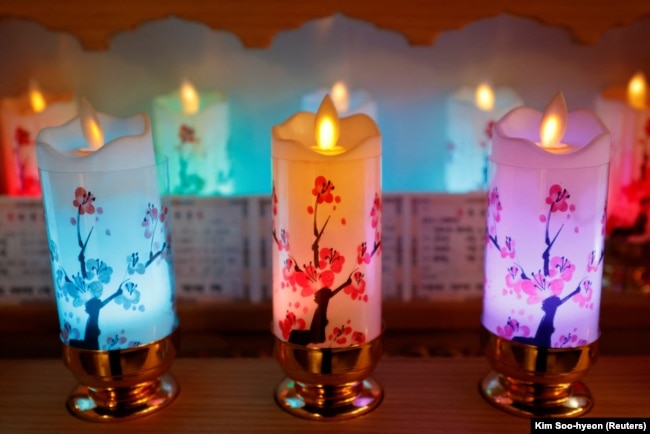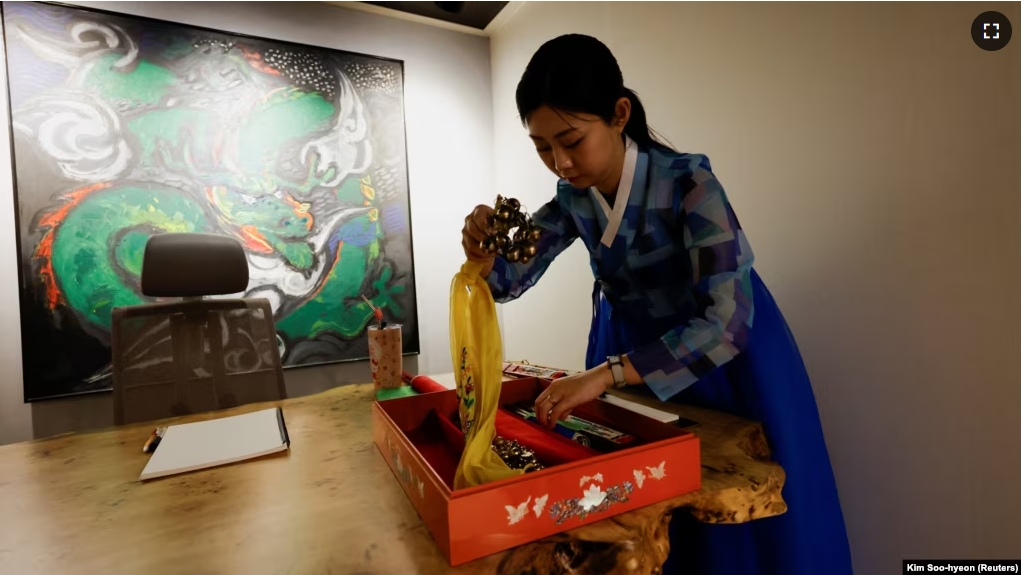In South Korea, the prayer table of Lee Kyoung-hyun looks similar to those of Korean shamans from hundreds of years ago. It has statues of Buddha and local gods, candles, and incense.
The 29-year-old shaman may use traditional prayer objects, but Lee reaches her followers in a modern way: through social media. Hundreds of thousands of people follow her online.
And she’s not alone. Since starting her YouTube channel in 2019, she has noticed more South Korean shamans posting videos about the spiritual practice.
Researcher Kim Dong-kyu is with the Academic Center for K-Religions at Sogang University, a private research university in Seoul. He said shamans used to publicize themselves in newspapers. He said it is “natural” for them to use social media.

Popularity of shamanism
South Korea is among the world’s most modern and high-tech economies. More than half its population of 51 million does not practice a religion, research shows. However, the appeal of shamanism remains popular and seems to be growing.
Google Trends tracks popular searches on YouTube. It shows that searches for “shaman” and “fortune-telling” in Korean have nearly doubled over the past five years.
A 2024 Korean film called Exhuma is about a shaman removing a curse on a family. The film has made at least $97 million dollars internationally and is raising interest in the religious tradition. The Korean Film Council says that one in five South Koreans has seen the film.

Relief from money worries
Shamans are thought to have special powers, including the ability to know what will happen in the future. They offer followers relationship advice, guidance on job searches, and predictions, said Lee.
Park Chea-bin is a 33-year-old Buddhist. In 2020, she visited Lee when she was struggling to find a job. She said she felt “peace of mind” after meeting with the shaman.
Park said, “I was very anxious at the time but I became a little relaxed after deciding to let things go and focus on what I need to do.”
She found a job at about the same time as her visit with the shaman.
Shaman Lee posts videos on subjects such as Korea’s future for the rest of 2024. “The current state of South Korean society is a factor that can’t be ignored,” she said. She added that many people come to her with concerns about the costs of housing and raising children.
In Seoul, where Lee works, the price of a home was more than 15 times the average wage in 2022. In 2017, a home in the Korean capital cost 8.8 times the average wage. These amounts come from a Korean government report. The country has also suffered from high inflation and interest rates.
Han Seung-hoon is an assistant professor at the Academy of Korean Studies, a research center under the Ministry of Education. Han says that younger shamans who live in the city connect well with their younger followers. These people are facing economic difficulties and are looking for help.
Roots of shamanism
In 2022, a culture ministry agency estimated that there were between 300,000 and 400,000 shamans and fortune-tellers in South Korea.
The agency website calls shamanism an “important and powerful” part of Korean tradition. Its roots date back at least 2,000 years, said Han.
Religious differences
Han also noted that larger religions such as Christianity and Buddhism make up about 40 percent of South Korea’s population. He added that they are more influential in society and do not receive similar criticism.
However, Lee said that Christians also visit shamans in South Korea. “Even…churchgoers want to have their bad dreams read,” she said.
Stigma attached to shamanism
“People used to hide that they live as a (shaman). There was a lot of stigma,” said 51-year-old Eunmi Pang. She has been a shaman for almost 20 years. She said that modern shamans are more willing to publicize themselves than those of the past.
The activities, or practices, of shamans may involve ringing bells and throwing rice. They may also sing and dance. Many worship local gods such as the Mountain God, Great Spirit Grandmother, and Dragon King.
More recently, some shamans have found themselves in legal trouble. Local media in Seoul reported that a 66-year-old shaman was sentenced to four years’ imprisonment in February. A court had found him guilty of cheating a follower out of $200,000.
Some people in South Korea’s influential communities have links to shamans.
Min Hee-jin is a top entertainment industry leader with a major K-pop music company. In April, she defended herself in a press conference against accusations that she used a shaman for business purposes. Min said she simply talked with a shaman to feel better: “Don’t you guys all do that too?” she asked reporters.
A 2022 report in the journal BMC Psychiatry noted a “huge” space between South Koreans needing mental health treatment and getting it. The report partly blamed this on stigma.
“People have stigmatized shamanism as something dirty, suspicious, and scary,” said Han, the assistant professor at the Academy of Korean Studies. He added that people were sometimes accused of visiting shamans in attempts to hurt their reputation.
I’m Anna Matteo.
For Reuters News Agency, Hyunsu Yim and Daewoung Kim reported this story from Seoul, Korea. Anna Matteo adapted it for VOA Learning English.
We want to hear from you. Our comment policy is here.
________________________________________________
Words in This Story
shaman – n. a priest or priestess who uses magic for the purpose of curing the sick, divining the hidden, and controlling events
fortune-telling – n. the act of foretell future events and especially the details of a person’s future
anxious – adj. afraid or nervous about what may happen
relaxed – adj. set or being at rest or at ease
focus – n. a center of activity, attraction, or attention
factor – n. something that contributes to the production of a result
stigma – n. a set of negative and unfair beliefs that a society or group of people have about something
entertainment – n. amusement or diversion provided especially by performers
reputation – n. overall quality or character as seen or judged by people in general
